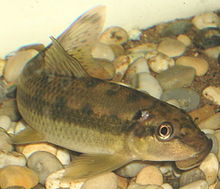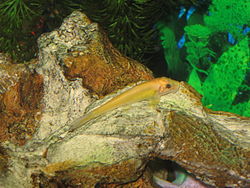- Gyrinocheilus aymonieri
-
Gyrinocheilus aymonieri 
Gyrinocheilus aymonieri Scientific classification Kingdom: Animalia Phylum: Chordata Class: Actinopterygii Order: Cypriniformes Family: Gyrinocheilidae Genus: Gyrinocheilus Species: G. aymonieri Binomial name Gyrinocheilus aymonieri
(Tirant, 1883)Synonyms Psilorhynchus aymonieri Tirant, 1883
Gyrinocheilus aymonieri is a freshwater fish that is native to large parts of southeast Asia[1]. It is of interest as a local food source and for the aquarium trade, being first imported into Germany in 1956.[2]
G. aymonieri is found in the Chao Phraya basin, northern Malay Peninsula, Mekong basin (in Cambodia, Yunnan province in China, Laos and Thailand), Mae Klong basin and Xe Bang Fai River[1]. It is most often seen in large rivers, occasionally entering flooded fields[3]. The fish spend most of their time on flat surfaces, such as rocks, in flowing water, using its unusually formed inferior mouth to attach itself to rocks in stronger flows[4].
The fish are sold in local markets as a food source and small fish are used in preparation of prahok.
Physical description
G. aymonieri has been recorded as reaching at least 28 cm (11.02 inches) SL and is the only species in the genus to have 9 branched dorsal rays, 36-40 lateral line scales[1] The mouth is inferior with a special "sucker" modification which allows the fish to attach itself to smooth surfaces. No barbels are present.[5]
Wild type colour varies from pale grey to olive, with darker markings along the lateral line which vary from a solid stripe with alternating higher and lower extensions to uneven dots. Belly is usually paler than the base colour. Some darker markings may also be observed along the back and on the caudal fin, but there are no dark markings on pelvic and anal fins[1].
In aquaria
G. aymonieri is similar in colouration to a number of other species which are commonly available in the aquarium trade, such as Crossocheilus oblongus, Epalzeorhynchos kalopterus and Garra cambodgiensis[5], and is sometimes mis-identified as one of the other species. This leads to some confusion about the reported behaviour of the fish as some of the similar species are peaceful, shoaling fish. The species rarely reaches its potential length in home aquaria, possibly because it is often kept in aquaria which are too small or in wrong conditions. It is available in a number of colour morphs, including wild type, gold, marble, albino and lecustic forms.
It is often recommended that the fish is kept in aquaria which are at least 120-150 cm (48-60 inches) long due to its adult size and high level of activity. Faster flows are also advised due to its natural habitat.
The species does not breed readily in home aquaria, although there are occasional reports of fry being found in overgrown aquaria[6]. At this time, there is no definitive knowledge of spawning triggers. Sexing is difficult, although mature males may develop breeding tubercles on their noses, while females become plumper[7].
G. aymonieri are often bough as algae eaters because they will readily eat algae when young, but with age, their preference changes towards meatier foods, such as generic prepared aquarium foods, frozen crustaceans and small fish. This change is also reflected in behaviour, which becomes aggressive with age, especially so towards others of their own kind and fishes with similar colors[8]. There have been reports in the online aquarium communities that the G. aymonieri will attack, and kill, even larger fish such as cichlids. Not through 'fighting' as such, rather it 'sucks on' to the side of larger fish, and keeps sucking until it removes skin, causing infection and often death. Unlike most fish, it does not need to open it's mouth for the intake of water, meaning that it can effectively suck other fish to death.
The two other Gyrinocheilus species, Gyrinocheilus pennocki and the Gyrinocheilus pustulosus, are rarely seen in the aquarium trade.
References
- Froese, R. & Pauly, D.,eds. (2011). Gyrinocheilus aymonieri in Catalog of Fishes.
- Froese, Rainer, and Daniel Pauly, eds. (2011). "Gyrinocheilus aymonieri" in FishBase. August 2011 version.
- ^ a b c d Kottelat, Maurice (July 1998). "Fishes of the Nam Theun and Xe Bangfai basins, Laos, with diagnoses of twenty-two new species (Teleostei: Cyprinidae, Balitoridae, Cobitidae, Coiidae and Odontobutidae)". Ichthyological Exploration of Freshwaters 9 (1): 1-128.
- ^ "Gyrinocheilus aymonieri". Aquaworld. http://aquaworld.netfirms.com/Cyprinoidae/Other/Gyrinocheilus_aymonieri.htm. Retrieved 2010-11-09. "First European import: Germany, 1956, by the firm Werner."
- ^ Taki, Y. (1978). "An analytical study of the fish fauna of the Mekong basin as a biological production system in nature". Research Institute of Evolutionary Biology Special Publications 1: 77.
- ^ Rainboth, Walter J. (1996). Fishes of the Cambodian Mekong. Rome: FAO (Food and agriculture organization of the United Nations). pp. 265. ISBN 92-5-103743-4. http://www.fao.org/docrep/010/v8731e/v8731e00.htm.
- ^ a b Frank, Neil; Liisa Sarakontu. "Algae Eating Cyprinids from Thailand and Neighboring Areas". The Aquatic Gardener: Journal of the Aquatic Gardeners Association. Aquatic Gardeners Association. http://www.aquatic-gardeners.org/cyprinid.html.
- ^ "Spawning Chinese Algae Eater (Gyrinocheilus aymonieri)". http://www.aquaticcommunity.com/mix/chinesealgaeeater.php. Retrieved 24 October 2011.
- ^ "How to keep Chinese algae eaters, Gyrinocheilus aymonieri, with pictures". Aqualand Pets Plus. 2006. http://aqualandpetsplus.com/Oddball,%20Chinese%20Algae%20Eater.htm. Retrieved 2010-11-09. "Sexing: Males develop breeding “horns” on their heads. Females get heftier."
- ^ "Chinese Algae Eater, Gyrinocheilus aymonieri" (PDF). PETCO Animal Supplies, Inc. 2004. http://www.petco.com/caresheets/fish/Algae%20Eater_Chinese.pdf. Retrieved 2010-11-09.
Categories:- Cypriniformes stubs
- Gyrinocheilidae
Wikimedia Foundation. 2010.

